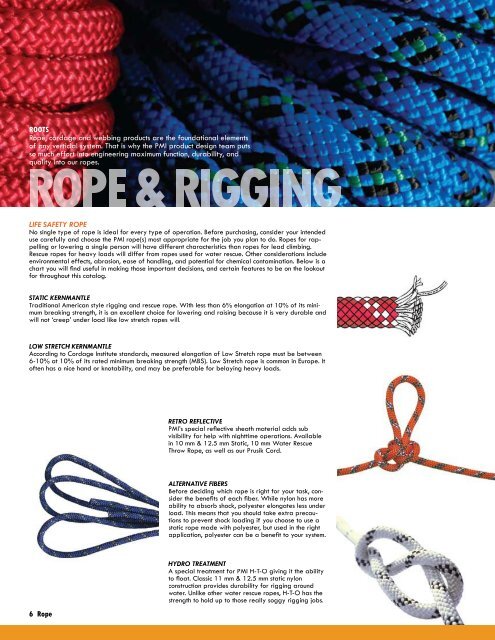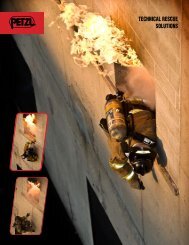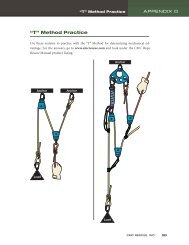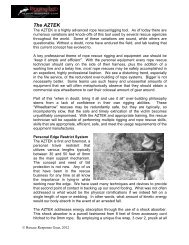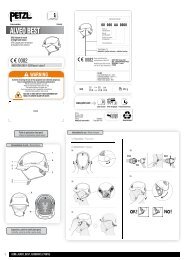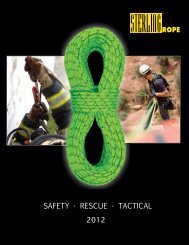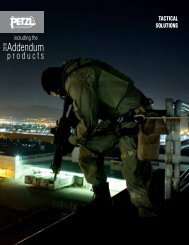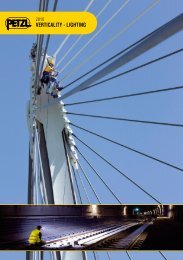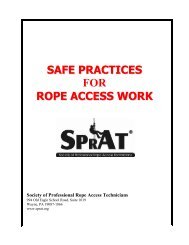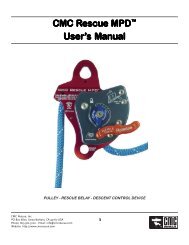Info | PMI Catalog 2008-2009 (pdf) - Rescue Response Gear
Info | PMI Catalog 2008-2009 (pdf) - Rescue Response Gear
Info | PMI Catalog 2008-2009 (pdf) - Rescue Response Gear
- No tags were found...
You also want an ePaper? Increase the reach of your titles
YUMPU automatically turns print PDFs into web optimized ePapers that Google loves.
ROOTSRope, cordage and webbing products are the foundational elementsof any verticlal system. That is why the <strong>PMI</strong> product design team putsso much effort into engineering maximum function, durability, andquality into our ropes.ROPE & RIGGINGLIFE SAFETY ROPENo single type of rope is ideal for every type of operation. Before purchasing, consider your intendeduse carefully and choose the <strong>PMI</strong> rope(s) most appropriate for the job you plan to do. Ropes for rappellingor lowering a single person will have different characteristics than ropes for lead climbing.<strong>Rescue</strong> ropes for heavy loads will differ from ropes used for water rescue. Other considerations includeenvironmental effects, abrasion, ease of handling, and potential for chemical contamination. Below is achart you will find useful in making those important decisions, and certain features to be on the lookoutfor throughout this catalog.STATIC KERNMANTLETraditional American style rigging and rescue rope. With less than 6% elongation at 10% of its minimumbreaking strength, it is an excellent choice for lowering and raising because it is very durable andwill not ‘creep’ under load like low stretch ropes will.LOW STRETCH KERNMANTLEAccording to Cordage Institute standards, measured elongation of Low Stretch rope must be between6-10% at 10% of its rated minimum breaking strength (MBS). Low Stretch rope is common in Europe. Itoften has a nice hand or knotability, and may be preferable for belaying heavy loads.RETRO REFLECTIVE<strong>PMI</strong>’s special reflective sheath material adds subvisibility for help with nighttime operations. Availablein 10 mm & 12.5 mm Static, 10 mm Water <strong>Rescue</strong>Throw Rope, as well as our Prusik Cord.ALTERNATIVE FIBERSBefore deciding which rope is right for your task, considerthe benefits of each fiber. While nylon has moreability to absorb shock, polyester elongates less underload. This means that you should take extra precautionsto prevent shock loading if you choose to use astatic rope made with polyester, but used in the rightapplication, polyester can be a benefit to your system.6 RopeHYDRO TREATMENTA special treatment for <strong>PMI</strong> H-T-O giving it the abilityto float. Classic 11 mm & 12.5 mm static nylonconstruction provides durability for rigging aroundwater. Unlike other water rescue ropes, H-T-O has thestrength to hold up to those really soggy rigging jobs.


